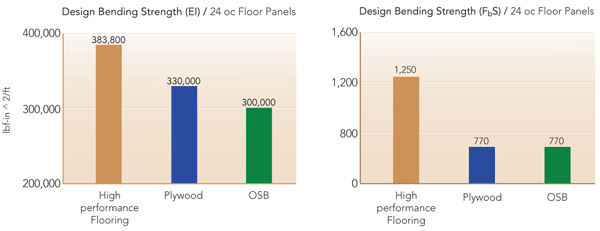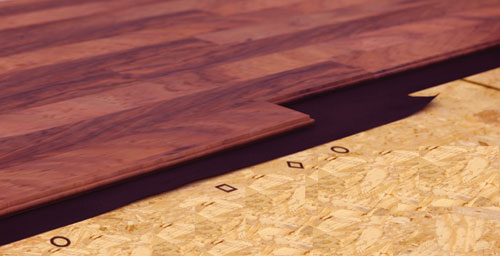The Makings of a Great Subfloor
To the Highest Standard
Architects should be aware of the higher standard to which high performance paneling is certified.
Both plywood and OSB are considered structural panels and treated equally in the building codes. The International Building Code defines OSB as wood structural panels intended for structural use complying with the requirements of Department of Commerce PS 2, Performance Standard for Wood-Based Structural-Use Panels. Section 2303.1.4 of the IBC states that every panel shall be designed and fabricated in accordance with the applicable standard and identified by the trademarks of an approved testing and inspection agency indicating conformance with the applicable standard. Two of the more recognizable companies that have been accredited by the International Accreditation Service (IAS) for testing and inspection of wood structural panels in the U.S. are the Timber Engineering Company (TECO) and APA–The Engineered Wood Association. PS 2 is a voluntary product standard that establishes the performance criteria for structural panels based on their end-application. It details testing procedures to qualify the product and quality control provisions to manufacture the product. All manufacturers of OSB must comply with the requirements outlined in PS 2 and plywood must meet either PS 2 or PS 1.
All approved testing and inspection agencies for wood structural panels, specifically OSB, test and inspect to the same PS 2 standard. When a panel is identified in the grade stamp by the trademark of an approved testing and grading agency, it indicates that the panel conforms to PS 2. Individual testing agencies do not have their own performance standards. They only test to ensure that panels satisfy the requirements of the IBC by ensuring conformance to PS 2. For the purpose of design, panels bearing the trademark of TECO or APA should be considered equally capable of satisfying minimum performance requirements. High performance panels may be subject to meeting performance requirements that exceed the PS 2 minimums and will be indicated by being stamped with an Evaluation Service Report (ESR) number or some other identifying mark.
ESRs are reports issued by evaluation services, like the International Code Council (ICC) Evaluation service, which is the most preferred resource used by code officials to verify that new and innovative building products comply with code requirements. ESRs are mostly referenced by architects, structural engineers, and other design professionals when specifying and selecting building materials. They detail the code requirements or acceptance criteria used to evaluate the new product and the evidence submitted to prove its conformance.
Manufacturers of engineered strand products with properties superior to those established under PS 2 can differentiate their products with an ESR. For years builders have had choices in dimensional lumber selection by product quality via grades—SS, #1, #2. Architects and builders now have the same choices in panel products with an ESR.
ESR 1785 is one example of an evaluation report verifying that high performance panels have greater strength characteristics than panels that meet the minimum PS-2 standard. High performance panels have increased bending strength, bending stiffness, planar shear strength, axial compression strength and stiffness—all prerequisites to building a quiet stiff floor. Bending strength, which represents how much load a panel will hold along the 8-foot length before failure, is a critical component of the overall structural integrity, safety, and longevity of a building. High bending strength helps sustain a quiet, stiff floor over the lifetime of a home.
Bending stiffness represents how much load an engineering subflooring panel will resist bending on the 8-foot length under a heavy load. High bending stiffness will feel firm under foot and will not bounce or sag under a heavy load. Flooring that bounces or sags can crack tile, loosen hardwood flooring nails, and cause vibrations, resulting in floor squeaks and costly rework. As can be seen in the figure below, the bending stiffness of high performance panels outstrips that of plywood and OSB.
 |
A subflooring's strength and stiffness can also lead to lower costs. Mike Hancock of Hancock Building & Design in Edmond, Oklahoma, likes high performance panels for their high strength and minimal deflection. “The product allows me to use thinner sheets for the same cost as thicker plywood products,” Hancock says.
Through evidence submitted on product performance, PS 2 requires a 23/32 OSB subflooring panel to meet a parallel bending strength (EI) of 300,000 lbf-square inch/foot, and plywood subflooring panel to meet 330,000 lbf-square inch/foot. One manufacturer of high performance subflooring, however, engineers, manufactures, and tests to meet a parallel EI of 383,800 lbf-square inch/foot, which is 16 to 28 percent higher than that of plywood and OSB, meaning it offers superior strength and stiffness, less sagging or bounce, and consistent performance when installed on the jobsite.
 |
High performance subflooring is a suitable substrate for finish flooring options. |
Additionally, APA–The Engineered Wood Association, conducted 2,000 nail-withdrawal tests on OSB and plywood of different thicknesses using different types of nails and over multiple conditions, and determined, through the testing, that the equivalent specific gravity for nail withdrawal strength of APA OSB and plywood is 0.40. High performance panels have shown an equivalent specific gravity of 0.44, which was derived from testing evidence submitted for ESR-1785. This calculated to an allowable nail withdrawal value of 23 lb/inch of thickness for an 8d common nail, so a 23/32 panel would be 16 lb of nail holding strength. APA plywood and OSB only have a value of 13 lb. High performance panels perform more consistently and have greater nail holding capacity than traditional OSB panels meeting the PS-2 minimum standard. This means more structural stability and fewer floor squeaks than plywood or commodity OSB, leading to a smoother, less costly construction process with fewer callbacks.
Shane Lyle of Strathmore Floors in Atlanta, Georgia, specializes in finished flooring services and often handles rework associated with plumbing leaks. He maintains that homebuilders who choose high performance panels for subflooring spend less on construction costs, as it creates less rework for flooring professionals. “Due to rising costs in the construction industry in 2003 and 2004, we saw homebuilders switching from high performance subflooring to commodity oriented strand board because they felt it would decrease building costs,” says Lyle. “We found that the OSB reacts poorly to moisture and many times the subfloors and hardwoods in these homes had to be replaced. To fix the homes, we had to hire a full-time sanding crew, creating expensive and time-consuming rework.”
| High Performance Panels Lead to Customer Satisfaction |
Al Durden, construction supervisor for SF Communities in Macon, Georgia, builds quality, residential homes in Macon and surrounding communities throughout Middle Georgia. Recent alterations in SF Communities’ standard construction practices required Durden to build quieter, energy-efficient homes. By using high performance subflooring and other advanced building materials, Durden was able to meet the new standards and realized significantly increased overall homeowner satisfaction. “high performance subflooring was originally presented to me on trial basis, but after a handful of builds, I’ve personally seen the benefits we can create for our homeowners including quiet, stiff floors and overall a more energy-efficient home,” states Durden. “The subflooring has allowed us to receive 90 percent less warranty calls on squeaking floors. Once we learned through our research that it was the best flooring on the market, we adjusted our overall construction plan to use the product on all of our builds.” Durden says that customers noticed the difference. “Since we began using this subflooring and other energy-efficient building materials, the traffic to our communities has increased due to the curiosity of the product benefits, as well as the positive feedback from our homeowners,” says Durden. |









